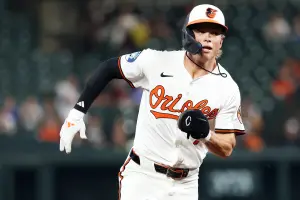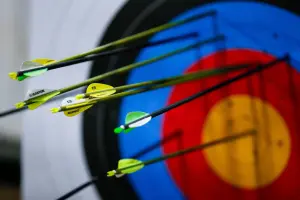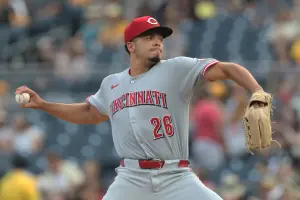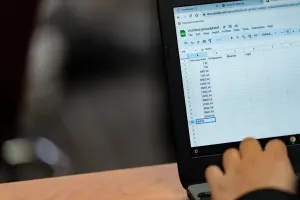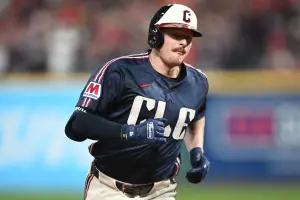
(*) ROTISSERIE: AL-LABR - If it ain't broke...
“If it ain’t broke, don’t fix it.” – pretty much every winner since the creation of the universe.
Last year, in preparation for AL-LABR, I wrestled with the question of what—exactly—is value in fantasy baseball, and how best to use it. In particular, I asked: When you’re in a league where everybody knows the player pool inside-and-out, and everyone knows your projections and strategy, how could you define the value plays and set yourself up for success?
Apparently, I succeeded—I won the league by 24.5 points. The foundation for that success came on auction day. But, hey—this is a redraft league, 2015 is a new year, and I’m starting with a blank slate. Time for the championship ring to go back in the drawer and see if I can repeat.
Mayberry Method 4.0 (MM4)
The 2014 team was built with Mayberry in mind, i.e, “embrace the imprecision.” We know we can’t project player performance with a high level of precision, so don’t stress out small differences between two projections. Mayberry breaks down the skillset into four components (power, speed, BA, and playing time for hitters; ERA, strikeouts, saves, and playing time for pitchers), and grades players on where they fall in each category.
Earlier this year, Ron Shandler detailed the last updates to the system, dubbed Mayberry 4.0. New for 2015 is the fact that, since offense has been sliding for years, rather than defining those categories by hard numbers, we now look at them compared to league average. I.e., instead of defining expected batting average in categories along the lines of .260-.270, we now use batting average index, where the average batting average in the league is defined as 100.
In addition to the Mayberry category scores, MM4 takes into account reliability. All players are graded (A-F) in health, experience, and consistency. For the tier-1 players in MM4—the expensive core that you’re building the team around—you need to make sure to get guys who grade well in all three categories.
Hitting—Know your league
After eight years in LABR, I know that the studs on offense are going for more than their standard BHQ projected value. The recent decline of offense in general makes it even more urgent—you need to pay for the power guys.
To take this into account, I switched the default 66/34 hitting/pitching split found in the Custom Draft Guide (CDG) and Rotolab to a hitting-heavy 70/30 split. Also, while the CDG takes a balanced approach between Stars and Scrubs and Spread the Risk, I changed Rotolab to stress Stars and Scrubs on offense and Spread the Risk for pitching.
I then highlighted as targets all hitters with Mayberry scores of 4 or 5 in the power and playing time categories with decent reliability scores—BBC or better (yes, I was willing to accept slightly less consistency to expand the talent pool).
Rather than budget a specific amount per position, I broke down my goals by power and speed. My goal was to spend up to $90 on three Mayberry 4/5 power guys to give me a good power base. For speed, I budgeted up to $50 for three players who ranked with a 4 or 5 in the speed category, bypassing the expensive guys like Altuve or Ellsbury. Considering my pitching budget, this left $40 for eight value plays (mostly concentrating on power upside) in the end game.
How it went: As defending champ, I got to nominate the first player, so I tossed out a trial balloon—Chris Davis. I don’t want Davis, at least until he proves that he can hit against defensive shifts. While he’ll slug plenty of HRs, I’m concerned that his BA won’t rebound much. Valued at $14 in 5x5, my “juiced” set up valued him at $21. He went for $26. Confirmation that the power guys were going to go above value.
Pitching—In search of mad skilz
Last year, I had great success by avoiding expensive starters, concentrating on guys in the $10-15 range who had solid peripherals. This allowed me to build a staff centered on Corey Kuber, Chris Archer, Garrett Richards, Rick Porcello, and Drew Smyly for a total of $57. Hitting on all of these guys obviously helped me create a dominant pitching staff.
Filtering helped identify the high skills starters. I concentrated on guys who were expected to post an xERA <= 3.70, Dom >=7.0, Cmd >=2.4, and hr/9 <= 1.0. In the past, starting pitchers in LABR tend to go at expected value—so by finding starters who met these filters, had decent reliability scores, and were projected to earn $10-$15, I could have a reasonable expectation on who would end up on my squad. I wanted to spend $60 or less on six starters. By spending $15-18 on a mid-level closer, along with a couple of $1, high-skills relievers who could end up with saves if the opportunity arose, I’d spend ~$80 on pitching.
How it went: Not as expected; the $10-15 starting pitchers were going for $5+ over my expected value. In hindsight, this makes sense; the AL lost a lot of high-value starters (Scherzer, Lester, Shields, now Darvish), so those pitching dollars went to those next in line. I had to adjust my strategy after a couple of rounds to account for this.
The team
Here’s how it looks ($R - my adjusted values):
Pos Name Team Sal $R Mayberry
=== =============== ==== === == ============
C Zunino, Mike DET 13 8 4005 20 BDF
C Conger, Hank HOU 2 -1 2003 6 AFC
1B Encarnacion, Edw TOR 33 30 4155 75 CAA
3B Moustakas, Mike KC 9 11 3125 60 ABA
CO Gallo, Joey TEX 1 -2 5401 9 AFF
2B Bonifacio, Emilio CHW 10 16 1525 65 DCB
SS Aybar, Erick LAA 16 18 1345 65 BAB
MI Schoop, Jonathan BAL 2 8 3115 50 ACA
OF Jones, Adam BAL 30 31 4345 80 AAA
OF Cabrera, Melky CHW 19 20 2245 65 CBF
OF Joyce, Matt LAA 8 9 3115 50 ABA
OF Dyson, Jarrod KC 9 14 0513 27 ADB
OF Gose, Anthony DET 3 8 1513 30 ACA
UT Carter, Chris HOU 24 26 5125 65 ABA
SP Iwakuma, Hisashi SEA 20 19 4205 55 CAA
SP Pineda, Michael NYY 11 10 3303 27 FDB
SP Salazar, Danny CLE 13 10 3403 30 ADB
SP Hahn, Jesse OAK 8 7 2103 18 CFF
SP Heaney, Andrew LAA 6 4 2101 4 ADA
SP Norris, Daniel TOR 4 3 2501 8 CFF
RP Smith, Joe LAA 2 7 5211 9 ACB
RP Cook, Ryan OAK 1 1 3410 8 CCA
RP Rodney, Fernando SEA 16 14 4530 36 BAA
RES Soriano, Rafael FA 0 2301 6 BAA
RES Rondon, Bruce DET 0 4500 0 FFA
RES Young, Delmon BAL 0 3333 36 BCB
RES Alvarez, RJ OAK 0 5500 0 AFF
RES Tazawa, Junichi BOS 0 3410 8 DDA
RES Warren, Adam NYY 0 3201 6 ACC
Mayberry score breakdown:
Batting PX RSpd xBA PA MM
======= == ==== === == ===
Actual 38 32 27 60 667
Target 37 23 32 54 600
Pitching xERA K Sv IP MM
======== ==== == == == ===
Actual 28 27 5 14 195
Target 17 27 5 25 320
Results
Power and Speed: It went pretty much as expected—power went at a premium. I paid the price to pick up three core power guys in Jones, Encarnacion, and Carter for $87, leaving me $3 to spend elsewhere. While Carter currently qualifies only as DH, he should gain 1B eligibility after a few weeks, which will allow me to slide him into Joey Gallo’s slot when I demote him.
I also got plenty of speed for well under my $50 budget. For $38, Bonifacio, Aybar, Dyson, and Gose project to steal 118 bases.
Batting average: My batting average isn’t good; I may have to take some of that speed and power and make some trades to get my average to a respectable level.
“What the hell?” moment: Mike Zunino (pictured) at $13?!? Really, Dave, are you off your rocker? By the time the good catchers came up in the auction, I had spent my power budget, so was reluctant to overpay for McCann ($19), Gattis ($24), or Gomes ($21). In hindsight, I probably should have pulled the trigger on one of them, since Zunino was the best catcher left when I paid the price, with several other owners in the same boat. Hopefully, a power-hitting catcher will attract some attention as I search for BA.
Starting Pitching: While I hit my targets for xERA and Ks, I didn’t get enough dependable starters. Rather than spend on pitchers with poor skills projected to earn $5-10, I took a stab at some highly-skilled pitchers who, in early March, are not locks for rotation spots. I’ll need Heaney and Hahn to contribute from the beginning.
I’ll be able to demote Daniel Norris before the season and dip into the FAAB pool to try to nab an unexpected starter coming out of spring training. How can you not spend a few bucks on a young millionaire who lives in a van down by the river?
Reserve rounds: My plan was to get some risky starters, since reserve players can be demoted/promoted weekly in LABR. But at that point, there were no starters I was willing to roster. Instead, I decided to go with “backup closers” to see if I could hit a cheap lottery ticket. If not, they’ll be cut to make room for demoted players from the rest of my roster.
Overview
Rotolab likes this team, putting it in second place, a few points behind the ever-competitive Larry Schecter. I’ve got some work to do before I can repeat as champ; time to start studying the waiver wire and getting ready for the first FAAB period!
Unlock all of our insights on your way to a fantasy title! See what our season-long coverage offers and then subscribe to BaseballHQ.com.


